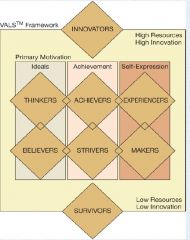![]()
![]()
![]()
Use LEFT and RIGHT arrow keys to navigate between flashcards;
Use UP and DOWN arrow keys to flip the card;
H to show hint;
A reads text to speech;
18 Cards in this Set
- Front
- Back
|
Self-concept |
the beliefs a person |
|
|
Self-concept is defined as |
the totality of the individual's thoughts and feelings having reference to himself or herself as an object |
|
|
Self-concept is divided into 4 parts: |

Private Self Social Self Actual Self Ideal Self |
|
|
Products can |
ØBe consistent with |
|
|
Independent self-concept |
emphasizes personal goals, characteristics, acheivements, and desires. Individuals with this tend to be individualistic, egocentric, autonomous, self-reliant. The define themselves in terms of what they have done, what they have, and their personal characteristics. |
|
|
Interdependent self-concept |
emphasizes family, cultural, professional, and social relationships. These people tend to be obedient, sociocentric, holistic, connected, and relation oriented. The define themselves in terms of social roles etc. |
|
|
Possessions and The |
-The extended self consists -Japanese business people view a |
|
|
Extended self can also |
|
|
|
Identity marketing |
consumers alter some aspects of their |
|
|
Products can: |
- Be consistent with |
|
|
Lifestyle is |
-how a person lives. -It is how one enacts his or her self-concept. |
|
|
Lifestyle✽ People sort themselves into groups |
- What they like to do |
|
|
Lifestyle is a |
key variable to segmentation in marketing |
|
|
Lifestyle: Psychographic Segmentation |
✽ To define target market |
|
|
Geo-Lifestyle Analysis (PRIZM) ✽ The underlying logic: |
-People with similar cultural backgrounds, means and perspectives naturally gravitate toward one another. ✽ Sample PRIZM Segments |
|
|
The VALS |
-provides a |
|
|
VALS is based on |

enduring psychological |
|
|
Underlying Differences Across VALS Motivational Types |

|

